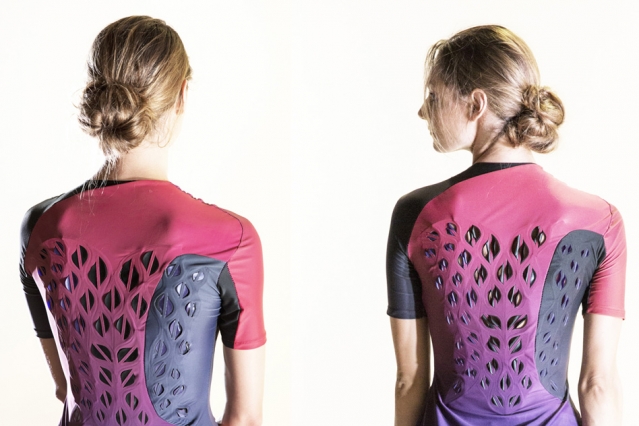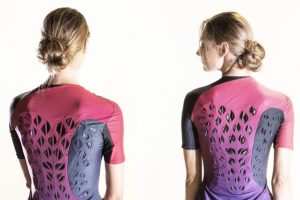
Image credit: Hannah Cohen (news.mit.edu)
MIT researchers have designed a ‘breathable workout suit’ with ventilating flaps that can open and close in response to an athlete’s body heat and sweat.

Image credit: Hannah Cohen (news.mit.edu)
The flaps are lined with live microbial cells that detect changes in humidity and prompt the flaps to act accordingly.
This means that the flaps will open when an athlete works up a sweat and shrink when the body has cooled off.
According to the researchers, the microbial cells used in the project require no additional elements to sense and respond to humidity, can be prepared quickly and in vast quantities, and are also proven to be safe to touch and even consume.
Wen Wang, the paper’s lead author and a former research scientist in MIT’s Media Lab and Department of Chemical Engineering, said the team was also able to engineer cells that express multiple functionalities in addition to moisture response.
“We can combine our cells with genetic tools to introduce other functionalities into these living cells,” Ms Wang said.
“We use fluorescence as an example, and this can let people know you are running in the dark. In the future we can combine odor-releasing functionalities through genetic engineering. So maybe after going to the gym, the shirt can release a nice-smelling odor.”
The flaps, which range from thumbnail- to finger-sized, are patterned across the suit’s back, with each flap designed to open to a degree determined by the area where the body produces heat and sweat.
“People may think heat and sweat are the same, but in fact, some areas like the lower spine produce lots of sweat but not much heat,” said former graduate student Lining Yao, who is now part of MIT’s Tangible Media group.
“We redesigned the garment using a fusion of heat and sweat maps to, for example, make flaps bigger where the body generates more heat.”
The researchers have already tested the running suit and had a number of study participants working out on exercise treadmills and bicycles while they monitored their temperature and humidity using small sensors positioned across their backs.
The suit’s flaps started opening up after five minutes of exercise, right around the time when participants reported feeling warm and sweaty.
According to the researchers, sensor readings indicated that the flaps effectively removed sweat from the body and lowered skin temperature, more so than when participants wore a similar running suit with nonfunctional flaps.
Wang tried on the suit herself and said that the flaps created a ‘welcome sensation’ after pedalling hard for a few minutes.
“It felt like I was wearing an air conditioner on my back,” she said.




















